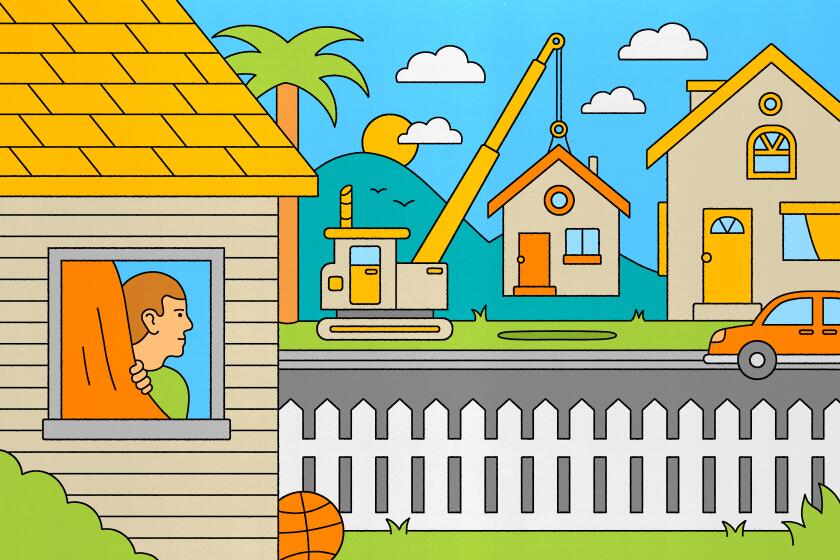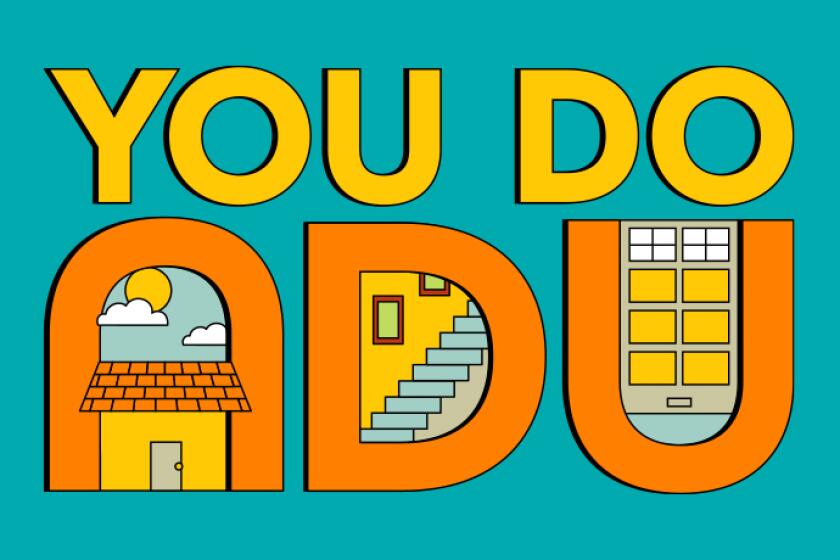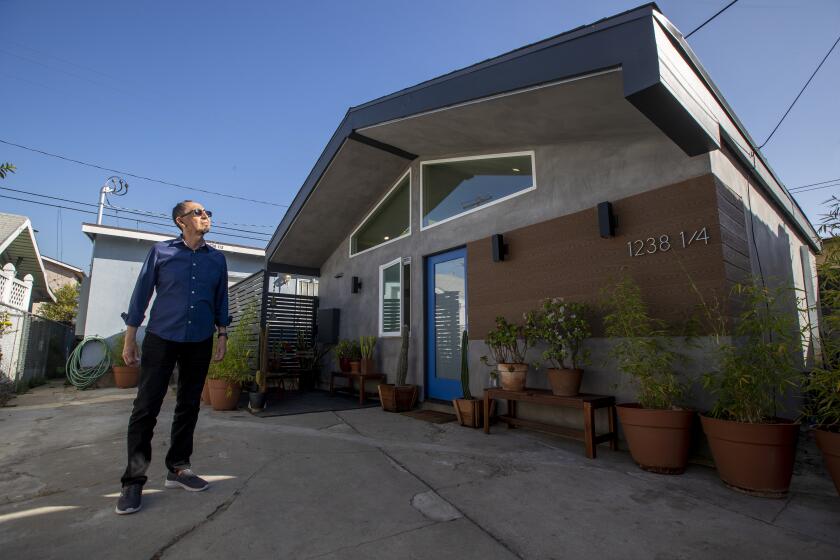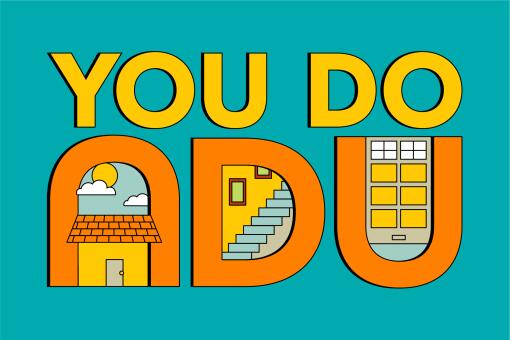You Do ADU, Part 2: How to pay for your ADU
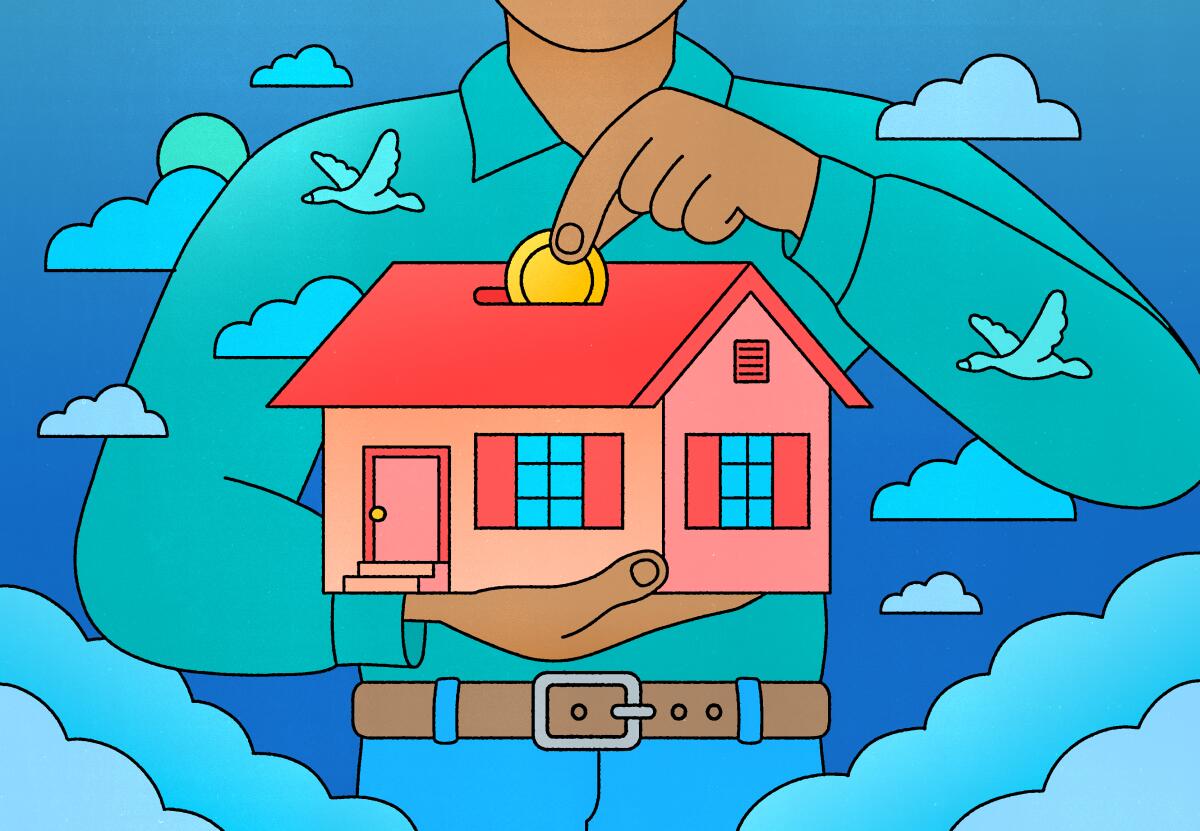
Once you’ve decided to build an accessory dwelling unit, the real fun starts: finding a way to pay for it.
That won’t be an issue if you’ve got enough money in the bank to buy a Ferrari — go ahead and start interviewing contractors. Everyone else will have to line up some kind of financing to cover not just the price of labor and materials, but also planning and permitting costs.
“We see very few ADUs completed for less than a couple hundred thousand dollars at this point,” said Alex Czarnecki, chief executive of the design-build firm Cottage. He said homeowners should expect to spend $20,000 to $30,000 on the design and permitting process alone.
Sign up for You Do ADU
Our six-week newsletter will help you make the right decision for you and your property.
You may occasionally receive promotional content from the Los Angeles Times.
And if you think inflation is bad at the grocery store, just wait until you see how prices have climbed in the construction industry. According to Verisk Analytics, labor and materials costs increased more than 11% in 2021 and 9% in 2022, driven largely by volatile lumber prices. Construction labor costs went up 34% over the last five years, Verisk found.
Making matters worse, interest rates are several percentage points higher than they were in the middle of the pandemic. But that increase cuts both ways; because full-sized homes are even less affordable now for young adult first-time buyers, parents are increasingly building ADUs to provide housing for their grown children.
“Higher interest rates, in a strange way, are a tailwind to the ADU business,” said Anthony Dedousis of Revival Homes, a Los Angeles-based firm that helps homeowners find financing and contractors for their ADU projects.
Although higher interest rates may not be dissuading people from putting an ADU on their property, they sure aren’t helping.
The first question to ask before deciding on an accessory dwelling unit is, ‘What am I trying to accomplish?’ Then check whether an ADU is the way to achieve that goal.
“It is considerably more difficult to get financing now” than it was before interest rates jumped, said Danny Shuster of Los Angeles-based Construction & Consulting Services. “There are still programs out there; they’re just not as affordable. The money is not as cheap.”
Meanwhile, he said, banks have become more tightfisted. Many borrowers are qualifying for half of what they could have borrowed a year ago, forcing them to scale back their ADU ambitions.
If you need help figuring out your options, there are multiple places to turn. A good starting point is the website of a nonprofit housing advocacy group such as the Casita Coalition, which offers a comprehensive guide to ADU financing. There are also counselors certified by the federal Department of Housing and Urban Development and groups like Long Beach-based HPP Cares that offer advice on how to pay for an ADU.
These services can bring a much-needed dose of realism to your ADU plans.
“That’s a huge thing for us, making sure that someone has a realistic budget, making sure someone knows about the financing options that are out there to help them and making sure … they’re going to build the right type of ADU,” said Renée Schomp, former director of the Napa Sonoma ADU Center.
A Google search will also turn up plenty of financing choices being touted by financial services companies. And then there are consultants like Revival Homes and builders like Shuster’s firm that will guide customers through the process of obtaining funding.
One other thing to remember if you’re counting on rental income to help pay back your debt: In Los Angeles and many other cities, you cannot use your new ADU for rentals of less than 30 days. That’s right: no Airbnb. And while your new ADU probably won’t be subject to rent control, you may have to comply with other local renter protections.
Small-space living is a big trend in Southern California. Get inspired by these local ADUs and learn how to plan your own build.
Here is a breakdown of some of the paths you can take to finance an ADU project, assuming that your petty cash fund is, in fact, petty.
Bank loans
There is a seemingly endless variety of loans, but Dedousis said “there isn’t really a lending product on the market right now that is specifically designed for ADUs.” As a result, he said, “you kind of have to shoehorn an ADU into an existing home-finance product. That can work for some people.”
One problem for banks is that ADUs are a relatively new phenomenon — at least, ADUs built with permits are — so there’s a limited amount of data about an ADU’s effect on property values. The more conservative the appraisal, the less a bank will be willing to lend for the project, potentially forcing you to scale back or abandon your plans.
Your income also determines how much you can borrow, and builders say that few lenders are willing to factor in the income you could collect from the ADU you’re building. One impediment is the stance of Fannie Mae and Freddie Mac, the two biggest buyers of housing-related loans, whose guidelines don’t allow lenders to consider future ADU rents, said Susan Brown, CEO of the CoreSGB housing consultancy in North Plains, Ore.
Freddie Mac has adapted its guidelines to support some loans used to build new ADUs or renovate old ones. But even under those guidelines, borrowers can’t factor in ADU rental income unless they have a lease signed before their first mortgage payment is due.
Within those constraints, local banks and their online counterparts offer several pots of money that can be used to build an ADU. Which one works best for you will depend on your income, home equity level and current home mortgage.
State and local rent-control measures do not apply to many ADUs. But building one may put the house on that property under rent control.
Cash-out refinancing. The simplest way to finance an ADU may be to do a “cash out” refinancing of your home mortgage, which rolls the unpaid balance of your current loan into a new loan that would also cover the cost of the ADU. The interest rate tends to be a little higher than a 30-year mortgage, but it’s often lower than other types of bank financing. The closing costs can be substantial though.
This option is available mainly to people who’ve built up a lot of equity in their home. For example, assume your house is worth $900,000 and your lender will let you borrow up to 80%, or $720,000, in a refinancing. If you still owe $600,000, the maximum amount of cash available is $120,000. But if you owe $400,000, the amount of cash available grows to $320,000.
The situation is evolving, Brown said, as a small but growing number of lenders are factoring in the value of the completed ADU when deciding how much you can borrow. The calculations are complicated, though, because of the limited amount of data about how ADUs affect property values.
Fannie Mae allows lenders to include the value of the completed ADU, but it caps loans at 75% of the total value. Some lenders will go further; for example, RenoFi will let you borrow as much as 90% of the value of your home with a completed ADU.
The idea of exchanging a mortgage obtained when rates were 3% or lower for a new one at more than 6% is unappealing, to put it mildly. But Larry Clinton, senior vice president of Infinity Lending Services in Redlands, said the main thing to consider is how much the higher rate compares with the return you’ll get on your investment. In other words: How long will it take to offset your costs with rental income from the ADU? Or if you’re building the ADU to avoid putting your daughter in a dorm room or your father in assisted living, how do the costs compare with the savings?
He also said that lenders can work with you and your builder to find ways to lower the interest costs on your loan. For example, his firm works with the Home Gallery to lower the borrower’s rate by prepaying some of the interest.
The more you owe on your mortgage, the more you’ll be hurt by swapping a low-interest rate for a higher one. The pain may be temporary, however. The bet you’ll be making is that interest rates will come down fairly soon, allowing you to refinance your new mortgage at a rate that’s closer to the one you’d be giving up in the cash-out refinancing today.

Southern Californians are racing to build accessory dwelling units — or ADUs — small, fully equipped homes on the same lot as a larger house. But building an ADU can be complicated and expensive. Architect Bo Sundius of Bunch Design suggests you keep these considerations in mind.
Home equity loan or line of credit. Many homeowners have seen an enormous increase in their home equity over the last few years, thanks to the hot housing market. If you want to tap that equity but can’t bear to part with your current mortgage, you can finance an ADU with a home equity loan or line of credit. These forms of credit typically carry interest rates a little bit higher than a standard 30-year mortgage or a cash-out refinancing, but the closing costs are lower.
A home equity loan (also called a second mortgage) is a lump sum you borrow at the start of the project that you hope will be large enough to cover all your bills. A home equity line of credit lets you borrow in increments to pay bills as they come in, delaying the onset of interest charges and keeping the amount borrowed (and the total interest owed) to a minimum. But the interest rate charged by a HELOC may change with each increment.
The issue with these methods, as with cash-out refinancings, is that they won’t cover the cost of an ADU unless you have built up a significant amount of equity in your home. Most are capped at 80% or 90% of the value of your home, minus your current mortgage balance. “That leaves new homeowners — even if they’re good credit risks, even if they have relatively high incomes — a bit high and dry,” Dedousis said.
Construction loans. These are short-term loans with interest rates that are usually one or more percentage points higher than the going rate for mortgages. The loan is paid out in stages to your contractor as the work is performed.
Monthly payments stay low because you’re not trying to pay down the loan; instead, when the ADU is finished, you’ll need to pay off the (very large) balance or roll it over into a conventional mortgage. Some construction loans even convert automatically to a mortgage, saving you from having to pay closing costs twice.
A construction loan often will require a down payment of 20% or more, which means you’ll have to cover a significant portion of the project cost yourself. And getting approved can be trickier — the loan won’t be secured by your house, and an appraiser has to determine that the ADU will add at least as much value as the loan amount.
If you shop around, though, you can find ADU construction loans that are more affordable than the typical offer. For example, the nonprofit Napa Valley Community Foundation partnered with Redwood Credit Union to develop a below-market-rate construction loan (4.375% on a 20-year loan as of late March).
The credit union factors in future income and property appreciation from the ADU to enable lower-income and lower-equity homeowners to qualify for loans large enough to build their project, said Schomp, of the Napa Sonoma ADU Center. “This is a pilot product, so we’re still waiting to see how effectively it catalyzes the market,” she said.
Another example is CrossCountry Mortgage in San Diego, which is offering a construction HELOC based on 125% of the future appraised value of the property. Loan officer Meredith Stowers said the company will factor in 75% of the expected monthly rent, which should make the lines of credit more accessible to people with moderate incomes.
Renovation loans. A type of unsecured personal loan, these carry a considerably higher interest rate than a mortgage. According to Bankrate.com, they range from 6.5% to 36%, depending on your income, debts and credit rating.
The main advantages are that the approval process is speedy and the fees are low.
Do your homework
Is the world of housing finance alien and kinda scary? Here are a few easy-to-digest explainers that can help you understand the choices.
Public aid
In addition to making it easier to get permits for an ADU, state lawmakers sought to help lower-income Californians clear some of the financial hurdles to building one. Last year the state created a $100-million grant program for low- and moderate-income Californians to cover up to $40,000 in planning and permitting costs.
Although those dollars have all been spoken for, the grant program is due to receive an additional $50 million in the current fiscal year. That money is on hold, however, while the California Housing Finance Agency studies other potential sources of funding for the program. The fate of the grants may hinge on whether state officials can drum up support for them from foundations and other private-sector sources.
Neither the city nor the county of Los Angeles currently provides grants for ADU construction. But on a smaller scale, Office of: Office, an L.A.-based urban planning and design firm, operates the Backyard Homes program to help homeowners build ADUs in exchange for a commitment to house low-income Angelenos.
Elizabeth Timme, the firm’s founder and design director, said ADUs are a way to expand the amount of “naturally occurring affordable housing,” a category that represents more than half of the supply of affordable units — many of them built without permits. Building more of this sort of housing, she said, is a form of resident-led community development.
The Backyard Homes program offers participants a variety of free ADU plans, then works with them to arrange financing and line up construction through its partners, Timme said. Finally, the program works with other partners to connect the ADU owners with tenants who have Section 8 vouchers.
The program is accepting applications only from homeowners in the city of Los Angeles, Timme said, adding that her nonprofit is working with other cities and local governments on similar programs.
Pasadena has a Second Unit ADU Program that provides financial assistance for ADUs, whether new or upgraded from an unpermitted unit. The program’s website said it’s closed to new applications at the moment, but it was tentatively scheduled to reopen in the spring of 2023.
Some other cities and counties are still offering to directly subsidize the construction of ADUs. For example, Napa County approved a $5-million program late last year that will cover about a third of the construction cost in exchange for a five-year commitment to charge rents that are affordable to residents making no more than 80% of the area median income.
The effort could provide housing for as many as 160 lower-income people, but “this will not solve the affordability issue in Napa,” said Jennifer Palmer, housing and homeless services director for Napa County. Instead, she said, the goal is to see whether the approach creates more badly needed housing, and if so, scale it up.
Brown said cities across the state are launching pilot programs all the time to promote ADUs, so it makes sense to keep tabs on what your local government is doing. “Stuff is popping up everywhere; you just have to keep the scanner going,” she said.
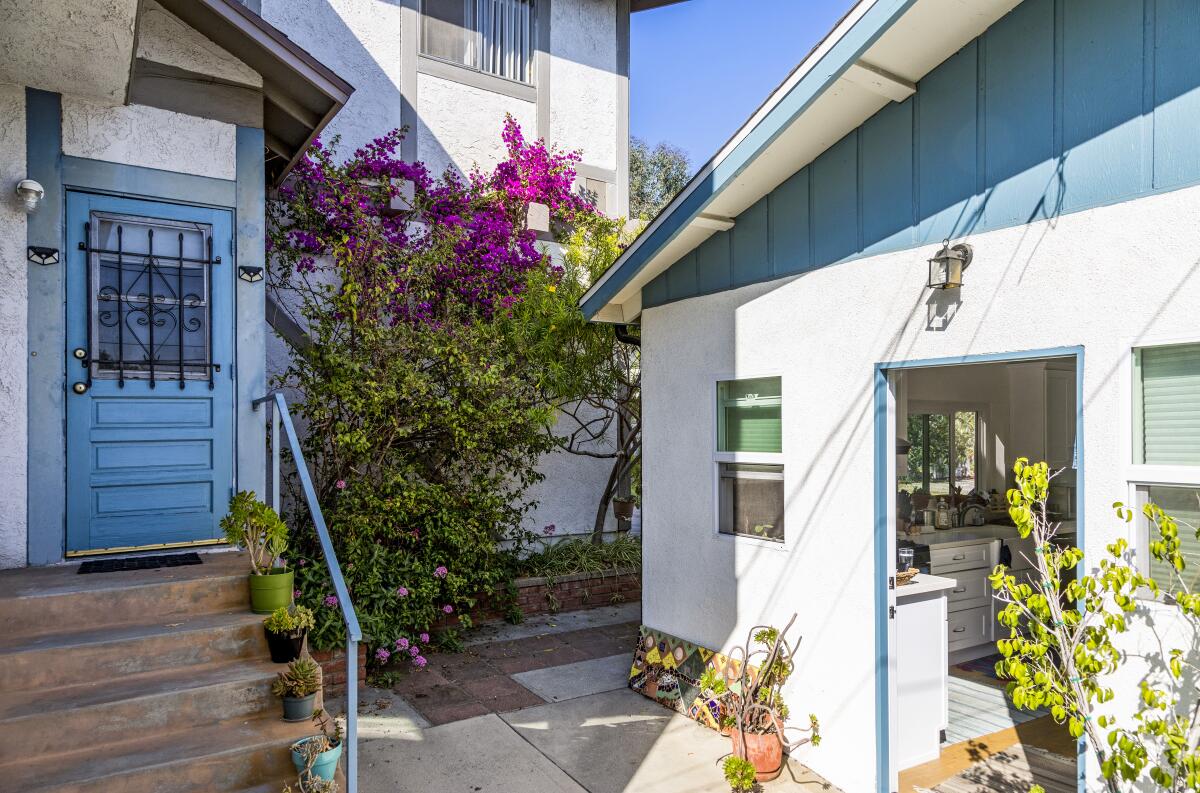
Personal assets
Dipping into your savings and investments to cover at least part of the cost of an ADU could make sense, but it’s not a simple decision. In fact, just thinking about the variables involved could make your brain hurt.
What you’re trying to do is compare what your savings could earn if left where they are against what you could save in interest payments and what you could gain from higher property values. But unless your money is invested in something with a fixed return, like a certificate of deposit, or parked somewhere that pays no interest, like a checking account or a mattress, you don’t know what your future earnings will be. Instead, you have to look at how similar investments have performed in the past. For example, large company stocks have grown almost 6.3% per year in value since 2000, not adjusting for inflation.
Similarly, you don’t know how much your property value will increase after your ADU is built. Property values have skyrocketed in L.A. County over the past decade, growing by about 8% per year on average. But it’s been a bumpy ride at times; median home sale prices were about 12% lower in December 2022 than they’d been in May.
We want to hear from you
Are you building an ADU or considering one? Do you have insights to share or unanswered questions? Or horror stories? Tell us.
One other complication is taxes. If you cash out an investment that has grown over time, you’ll owe taxes on the increase in value (i.e., the capital gain) of up to 20% on both your federal and state returns. That makes the idea of using savings to reduce your loans less appealing.
What your investments are earning, how much they’ve gained and what tax bracket you occupy will all affect your calculations. Nevertheless, the higher the interest rates on loans climb, the easier it is to make the financial case for shifting some of your savings and investments from stocks and bonds to an ADU.
If you have a 401(k), your employer may allow you to borrow from it to build your ADU. Under IRS rules, the loans must be repaid within five years. They’re also capped at $50,000 or half of your vested amount, whichever is lower.
The distinct advantage of tapping your 401(k) is that the interest you pay on the loan will go back into your account, not to a bank or other lender. But unless the interest rate is at least as high as the returns on your 401(k) investments, you’ll end up reducing your retirement savings over the long term. And if you don’t pay the loan back on time, the remaining balance would be taxed as ordinary income and, if you’re less than 59½ years old, subject to an additional 10% penalty for early withdrawal.
Brown said you could cobble together a bunch of short-term help — for example, borrowing from relatives, taking out a 401(k) loan and maxing out your credit cards — then pay it all back by refinancing your mortgage with additional debt to cover your ADU costs. And if you do it this way, she said, Freddie Mac’s guidelines will allow lenders to factor in the rental income from your newly built ADU.
Finally, if you are 62 or older, one more option is a reverse mortgage. This, too, is a way to borrow against the equity of your home, but you won’t try to pay off the loan or even make monthly payments. Instead, the debt will grow as interest accrues until the house is sold.
There are a slew of reasons not to go this route, especially if you want to bequeath your home to someone. But if you have little income and a lot of home equity, a reverse mortgage could make the numbers work for your ADU.
One set of grandparents moved into an ADU, then refugees, and one day more grandparents may move in too. Their ADU is a symbol of multigenerational living.
Equity financing
Several tech-oriented startups offer cash in exchange for some of the future value of your home. The type of financing offered by the likes of Point, Hometap, Unlock and Unison is called “shared equity,” and the money you’ll receive isn’t a loan — these companies are investing in your house. So you won’t have to make monthly payments or worry about interest, but you will give up some of the gains you’d reap when you sell your house for a profit.
“That could work as a last resort,” Dedousis said, “but it’s a pretty darn expensive way to finance construction.” After all, he said, one of the reasons you’re building an ADU is to increase the value of your home, and “it’s a tough thing to give up some of that upside.”
But if you have little equity in your home, limited savings, low income or a lousy credit rating, this approach may be one of your few viable financing options.
About this newsletter
Sign up for You Do ADU
Our six-week newsletter will help you make the right decision for you and your property.
You may occasionally receive promotional content from the Los Angeles Times.
